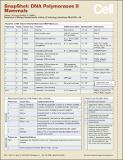SnapShot: DNA Polymerases II Mammals
Author(s)
Foti, James J.; Walker, Graham C.
DownloadWalker_Snapshot DNA.pdf (147.2Kb)
PUBLISHER_POLICY
Publisher Policy
Article is made available in accordance with the publisher's policy and may be subject to US copyright law. Please refer to the publisher's site for terms of use.
Terms of use
Metadata
Show full item recordAbstract
DNA polymerases ensure the faithful duplication of genetic information inside the nuclease and mitochondria of eukaryotic cells and the nucleoid of prokaryotic cells. These remarkable enzymes synthesize polynucleotide chains based on the complementarity of an incoming nucleotide to an existing DNA template. DNA polymerases are grouped into six families (A, B, C, D, X, and Y). The previous SnapShot (DNA Polymerases I Prokaryotes) described the structural and functional characteristics conserved across the families, using the DNA polymerases from the bacterium Escherichia coli as an example. In this SnapShot, we now highlight DNA polymerases from humans (Homo sapiens) and their relationship to human diseases. However, this list is certainly not exhaustive, and the number of putative links between DNA polymerases and diseases continues to grow.
Date issued
2010-04Department
Massachusetts Institute of Technology. Department of BiologyJournal
Cell
Publisher
Elsevier B.V.
Citation
Foti, James J., and Graham C. Walker. “SnapShot: DNA Polymerases II Mammals.” Cell 141, no. 2 (April 2010): 370–370.e1.
Version: Final published version
ISSN
00928674